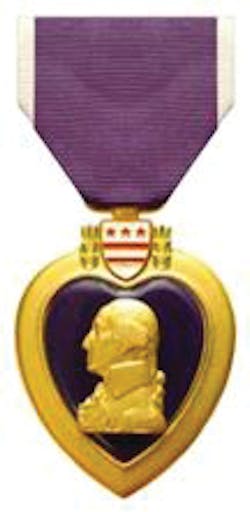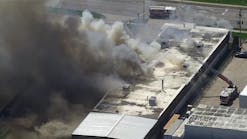Sunday morning, 0800 hours in Hawaii. The day shift was starting in Honolulu firehouses on Dec. 7, 1941. The sun was shining; the palms were swaying, another day in paradise.
Lieutenant Frederick Kealoha answered the ringing telephone in the quarters of Engine 6. He quickly sounded the house gong – Engine 6, first due at Hickam Field, was going to war. At the same time, off-duty Fireman Anthony Lopez was on his way to church when a low-flying plane with rising sun insignias flashed by. He thought it was all part of another practice exercise. There had been many the past several months.
Later, during the service, he heard the sirens of fire apparatus pass the church; a short while later, more rigs screamed by. He knew it was a second alarm, a big fire. He left church and headed home to grab his gear. On his car radio the music turned to news. It was an attack. Enemy planes were attacking Oahu. Planes were bombing Pearl Harbor. Then the radio went dead.
As Engine 6 raced to the airfield, the firefighters on the back step could see towering columns of roiling smoke with flames leaping hundreds of feet into the clear-blue sky. Also in the sky were puffs of black smoke – anti-aircraft shells bursting in the distance as American military forces tried to fight back. The frequency of anti-aircraft fire slowed, causing the firefighters to think the attack may be over. The engine pressed on through a sea of parked cars and staring civilians cluttering the small, two-lane road. Drivers pulled over to watch as the panorama of war blossomed before their eyes.
Reaching the main gate, the men of Engine 6 were relieved that the bombing, strafing and anti-aircraft return fire had stopped, but were awed by what they saw. An underground gas main had been hit and was spewing flames dozens of feet into the air right near the front gate. As they passed the column of flame the bigger picture began to come into focus. Dead, dying and wounded military personnel lay everywhere, a large barracks struck by a bomb was burning fiercely. Across the road aircraft hangars and a quarter-mile-long line of parked planes were also blazing.
Arriving at the fire station, as per their mutual aid response, the firefighters saw one of the Hickam Field fire engines had been strafed on the apron, its driver dead at the wheel. The other engine was still inside. Now joined by Engine 4, they found they were the only firefighting force available to handle the multiple fires, rescue efforts and body recoveries surrounding them. With no other authority, military or otherwise, Kealoha assumed command. The crew of Engine 1, who had responded from downtown Honolulu, joined them as Kealoha and his men sized-up their situation and sprang into action.
During the first wave of the attack, a bomb had struck the airfield’s water main, leaving all the hydrants out of service. Nearby, a huge bomb crater was rapidly filling with water and Kealoha decided to try drafting from the crater to get some water on the fires. Men were stretching hoselines, positioning rigs and fighting fires as the second wave of Japanese planes appeared from the south, swooping down over Diamond Head and racing across Waikiki Beach. Fire officers ordered their men to take cover as the planes swarmed in.
The Imperial Japanese Navy had sent another wave of carrier-based fighters, dive bombers and bombers to again attack “Battleship Row” – the U.S. Navy fleet anchored at Pearl Harbor, Ford Island, Hickam Field, Wheeler Field and several other targets.
For the next 15 minutes, all hell rained down on the Honolulu firemen and the remaining military scattered across the airfield. Bombs whistled in, shaking the ground as they detonated, one after another. Streams of machine gun bullets screamed from the sky, stitching death across the smoke-filled fireground. Shrapnel ripped through the air, tearing at those huddled on the ground trying to make themselves invisible to the pilots and machine gunners above.
Finally, the onslaught slowed. The planes receded into the horizon and the firemen warily crept from their makeshift shelters. They immediately ran to aid the injured and took stock of the dead. Three members of the Honolulu Fire Department were dead: Captain Thomas Macy of Engine 4 and Captain John Carreira Engine 1 were killed by a Japanese bomb that fell through a hangar roof while they were battling flames inside; Hoseman Harry Tuck Lee Pang of Engine 6 was killed by a machine gun burst from a Japanese fighter plane. Kealoha and Hoseman Moses Kaliikane were critically injured. Three other firefighters were seriously injured.
The firefighting force spent their first few minutes tending to the injured firemen and soldiers. Around them their fire apparatus had taken a similar beating from the aerial assault. Shrapnel pierced Engine 1’s chemical tank, Engine 6 had suffered countless bullet holes and the hose wagon was in flames. The remaining apparatus suffered everything from shrapnel hits to flat tires and radiators gushing steam from bullet holes.
As the wounded were cared for, several hoses were pulled into position and again water hit the flames. Then, a third attack commenced.
Running for their lives, with machine gun bullets snapping at their heels, firemen dove for cover. Luckily, the latest attack was over quickly and emergency work was renewed. This time, the efforts of the firemen and soldiers was bolstered by civilian volunteers who had descended on the airfield. Firemen scrambled to repair their rigs and get them back into service – bars of brown soap and wads of toilet paper were plugged into leaking radiator holes.
A real fire attack finally commenced. Three pumpers dropped hard suctions into the large bomb crater and drafted water to feed the attack lines. Hoses moved in on burning aircraft, holding the spreading walls of fire and protecting other aircraft and hangars yet to catch fire. With limited water, no master streams would be available and the fires were fought using 1½-inch hoses. Realizing that Pearl Harbor had also been attacked, the proof filling the sky in the near distance, Honolulu firemen knew there would be no reinforcements. They had to do the best they could with what they had.
The five two-piece companies on scene, with depleted manning due to deaths and injuries, pressed on at Hickam Field. All off-duty Honolulu firefighters were recalled to duty to man the remaining five pumpers and five hose wagons left to cover the rest of the city. Nine commercial trucks were pressed into service as auxiliary fire units with civilian volunteers under the command of a Honolulu fireman.
The department’s alarm bureau quickly became swamped with alarms from across the city: live electrical wires down; bomb strikes to buildings; several serious building fires; blazing gas storage tanks. The number of alarm boxes being transmitted was so great Chief William Blaisdell ordered that only phone alarms with specific addresses would be dispatched.
The department continued battling fires and responding to emergencies without rest until Tuesday morning, when the department began giving each man four hours off. A temporary work schedule was worked out that included an automatic recall whenever the air raid sirens sounded.
The entire Honolulu Fire Department showed extraordinary courage, fortitude and professionalism during the attacks that Sunday morning and the days afterwards. The men of the department were presented a letter of commendation from the military governor “for their gallant actions during the attack on Oahu, December 7, 1941.” This was epitomized by the six Honolulu firefighters who were later awarded Purple Hearts, commendations ordinarily reserved for military personnel wounded in battle. On June 13, 1944, a ceremony was held in the office of Lieutenant General Robert C. Richardson Jr., U.S. Army. The general awarded the Order of the Purple Heart to Lieutenant (now Captain) Frederick Kealoha and Hosemen George Correa, John A. Gilman, Moses Kalilikane, Patrick J. McCabe and Solomon H. Naauao Jr.
The three Honolulu firefighters killed on Dec. 7, 1941, finally received recognition for their heroism on Dec. 7, 1984, during a ceremony aboard the U.S.S. Arizona Memorial. Captain John Carreira, Captain Thomas S. Macy and Hoseman Harry T.L. Pang were awarded their Purple Hearts.
These nine men are the only civilian firefighters ever to be given this honor.
• • •
Author’s note – The majority of the information in this article is from two sources: History of the Honolulu Fire Department by Chief H.A. Smith, privately printed in 1950; and “December 7, 1941 – The Day the Honolulu Fire Department Went to War” by Professor John E. Bowen of the University of Hawaii, published in the Hawaiian Journal of History, Volume 13, 1979.
PAUL HASHAGEN, a Firehouse® contributing editor, is a retired FDNY firefighter who was assigned to Rescue 1 in Manhattan. He is also an ex-chief of the Freeport, NY, Fire Department. Hashagen is the author of FDNY: The Bravest, An Illustrated History 1865-2002, the official history of the New York City Fire Department, and other fire service books. His latest novel, Fire of God, is available at dmcfirebooks.com.
Paul Hashagen
PAUL HASHAGEN, a Firehouse® contributing editor, is a retired FDNY firefighter who was assigned to Rescue 1 in Manhattan. He is also an ex-chief of the Freeport, NY, Fire Department. Hashagen is the author of FDNY: The Bravest, An Illustrated History 1865-2002, the official history of the New York City Fire Department, and other fire service books.
Connect with Paul
Website: paulhashagen.com
Facebook: Paul Hashagen-author






